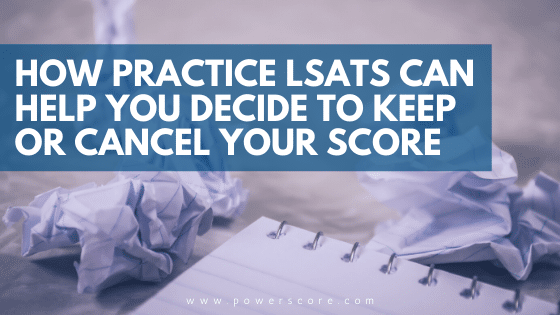Taking practice LSATs can do a lot for your test preparation. We talk about how to take PTs to replicate the testing experience as closely as possible here. While taking and analyzing PTs should be an integral part of everyone’s test preparation, we beg the question. Are you using each practice test to their full potential? Meaning, are learning everything you can from each PT? Certainly identifying your strengths and weaknesses and adapting your study plan to that is key. However, there is a valuable exercise you can use in conjunction with them that students underutilize. It’s a simple 3 step process that can help you determine whether you should keep or cancel your score.
Predict Your Score
While you don’t want to walk into the LSAT with a negative attitude, you should always follow the old adage of “hope for the best but prepare for the worst.” Thus, as you take practice tests, take time between the completion of the LSAT and before going over your score to perform the following tasks.
- Predict the number of questions you think you got correct in each section. Include the experimental section if one is in your exam. If necessary, make best-case and worst-case predictions for each section.
- Add the numbers up from item #1 above, but exclude the experimental section. Then use that number to predict your final score on the LSAT. If you use the best/worst approach, predict best-case and worst-case scores. Making this estimation will also force you to predict the scoring scale for the exam.
- On the basis of the predicted final score from the previous step, determine whether you would keep your score or cancel it.
Don’t Let an Actual LSAT Become Your Test Run
Most students don’t formally go through this process and hopefully, they’ll never need it. But, a lot of students take LSAT after LSAT and repeatedly end up debating between keep or cancel. They let actual LSATs become the live practice of this estimation process. If you’ve never tried this exercise of estimating your score before, your accuracy the first time is not likely to be that great. This means you’re making a decision on the basis of questionable data. So, while you hope to never be in a position of uncertainty of keeping or canceling your score, it’s best to prepare for it. You should always go through the score estimation and cancel decision process for every full-length PT you take.
At first, you may not be very good at it. But, you will get better! And that is the point of the exercise. Then, if you do need estimate your score after a real LSAT, you’ll have a much better feeling about how you did.
Bonus Exercise
If you really want to challenge yourself! After each test, write down a synopsis of the most challenging LR questions and LG and RC passages. Students who remember the most about the test tend to score the best. Those that don’t remember much at all, or who think the test was a blur, tend not to score as well as they could. See how much you can remember and see if that correlates with your actual practice test score for each exam. In that way, you can develop an accurate process to know what you should do after you take the real thing.


Leave a Reply